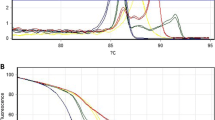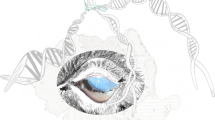Abstract
Paramphistomosis is caused by paramphistome or amphistome parasites, including Fischoederius elongatus, Gastrothylax crumenifer, Orthocoelium parvipapillatum, and Paramphistomum epiclitum. The control and prevention of these parasite outbreaks are difficult because of the wide occurrence of these species. Besides, the clinical manifestations and their egg characteristics are similar to those of other intestinal flukes in the paramphistome group, leading to misdiagnosis. Here, we employed DNA barcoding using NADH dehydrogenase (ubiquinone, alpha 1) (ND1) and cytochrome c oxidase subunit I (COI), coupled with high-resolution melting analysis (Bar-HRM), for species differentiation. As a result, ParND1_3 and ParCOI4 resulted in positive amplification in the paramphistomes and Fasciola gigantica, with significantly different melting curves for each species. The melting temperatures of each species obtained clearly differed. Regarding sensitivity, the limit of detection (LoD) for all species of paramphistomes was 1 pg/µl. Our findings suggest that Bar-HRM using ParND1_3 is highly suitable for the differentiation of paramphistome species. This approach can be used in parasite detection and epidemiological studies in cattle.





Similar content being viewed by others
Data availability
All DNA sequences of adult parasites obtained from DNA barcodes, ND1 and COI in this study were deposited in the GenBank database (NCBI) as OP939413-OP939415 and OP928154-OP928157, respectively.
References
Amer S, Dar Y, Ichikawa M, Fukuda Y, Tada C, Itagaki T, Nakai Y (2011) Identification of Fasciola species isolated from Egypt based on sequence analysis of genomic (ITS1 and ITS2) and mitochondrial (NDI and COI) gene markers. Parasitol Int 60(1):5–12
Anuar TS, Al-Mekhlafi HM, Ghani MKA, Bakar EA, Azreen SN, Salleh FM, Moktar N (2013) Evaluation of formalin-ether sedimentation and trichrome staining techniques: its effectiveness in detecting Entamoeba histolytica/dispar/moshkovskii in stool samples. J Microbiol Methods 92(3):344–348
Anucherngchai S, Chontananarth T, Tejangkura T, Wongsawad C (2020) Molecular classification of rumen fluke eggs in fecal specimens from Suphanburi Province, Thailand, based on cytochrome C oxidase subunit 1. Vet Parasitol Reg Stud Reports 20:100382
Anuracpreeda P, Chawengkirttikul R, Sobhon P (2016) Surface histology, topography, and ultrastructure of the tegument of adult Orthocoelium parvipapillatum (Stiles & Goldberger, 1910). Parasitol Res 115:2757–2769
Arias MS, Sanchís J, Francisco I, Francisco R, Piñeiro P, Cazapal-Monteiro C, Cortiñas FJ, Suárez JL, Sánchez-Andrade R, Paz-Silva A (2013) The efficacy of four anthelmintics against Calicophoron daubneyi in naturally infected dairy cattle. Vet Parasitol 197(1–2):126–129
Bhalerao GD (1935) On two new monostomes (Trematoda) from avian hosts in British India. Indian J Anim Sci 5(1):49–63
Boray J (1969) Studies on intestinal paramphistomosis in sheep due to Paramphistomum ichikawai Fukui, 1922. Vet Med Rev 4:290–308
Bowles J, McManus DP (1993) NADH dehydrogenase 1 gene sequences compared for species and strains of the genus Echinococcus. Int J Parasitol 23:969–972
Buddhachat K, Chontananarth T (2019) Is species identification of Echinostoma revolutum using mitochondrial DNA barcoding feasible with high-resolution melting analysis? Parasitol Res 118(6):1799–1810
Buddhachat K, Meerod T, Pradit W, Siengdee P, Chomdej S, Nganvongpanit K (2020) Simultaneous differential detection of canine blood parasites: multiplex high-resolution melting analysis (mHRM). Ticks Tick Borne Dis 11(3):101370
Chaudhry U, Van Paridon B, Shabbir MZ, Shafee M, Ashraf K, Yaqub T, Gilleard J (2016) Molecular evidence shows that the liver fluke Fasciola gigantica is the predominant Fasciola species in ruminants from Pakistan. J Helminthol 90(2):206–213
Chowdhury R, Sen A, Kar J, Nath SK (2017) Prevalence of gastrointestinal parasitism of cattle at Chandaniash Upazilla, Chittagong, Bangladesh. Int J Adv Res 4(6):144–149
Chryssafidis AL, Fu Y, De Waal T, Mulcahy G (2015) Standardisation of egg-viability assays for Fasciola hepatica and Calicophoron daubneyi: a tool for evaluating new technologies of parasite control. Vet Parasitol 210(1–2):25–31
Eduardo S (1985) The taxonomy of the family Paramphistomidae Fischoeder, 1901 with special reference to the morphology of species occurring in ruminants. VI. Revision of the genus Orthocoelium (Stiles & Goldberger, 1910) Price & McIntosh, 1953. Syst Parasitol 7(2):125–158
Eduardo S (1980) Orthocoelium indonesiense, a new species of amphistome from ruminants in Indonesia. Syst Parasitol 1(3):203–210
Eduardo S (1982a) The taxonomy of the family Paramphistomidae Fischoeder, 1901 with special reference to the morphology of species occurring in ruminants. I. General Considerations. Syst Parasitol 4(1):7–57
Eduardo S (1982b) The taxonomy of the family Paramphistomidae Fischoeder, 1901 with special reference to the morphology of species occurring in ruminants. II. Revision of the genus Paramphistomum Fischoeder, 1901. Syst Parasitol 4(3):189–238.
Fukui T (1929) On some Acanthocephala found in Japan. Annot Zool Jpn 12:255–270
Furda A M, Bess A S, Meyer J N, Houten B V (2012) Analysis of DNA damage and repair in nuclear and mitochondrial DNA of animal cells using quantitative PCR. In DNA Repair Protocols (pp. 111–132). Humana Press, Totowa, NJ
Hall T A (1999) January. BioEdit: a user-friendly biological sequence alignment editor and analysis program for Windows 95/98/NT. In Nucleic acids symposium series (Vol. 41, No. 41, pp. 95–98). [London]: Information Retrieval Ltd., c1979–c2000.
Hebert PD, Penton EH, Burns JM, Janzen DH, Hallwachs W (2004) Ten species in one: DNA barcoding reveals cryptic species in the neotropical skipper butterfly Astraptes fulgerator. Proc Natl Acad Sci 101(41):14812–14817
Hosseini-safa A, Rokni M B, Mosawi S H, Heydarian P, Azizi H, Davari A, Aryaiepour M (2019) High-resolution malting analysis as an appropriate method to differentiate between Fasciola hepatica and F. gigantica. Iran J Public Health 48(3):501
Jones A, Bray RA, Gibson DI (2005) Keys to the Trematoda, vol 2. CABI Publishing and The Natural History Museum, London
Khan I, Afshan K, Shah S, Akhtar S, Komal M, Firasat S (2020) Morphological and molecular identification of Paramphistomum epiclitum from buffaloes in Pakistan. Acta Parasitol 65(1):225–236
Li J, Zhao GH, Lin R, Blair D, Sugiyama H, Zhu XQ (2015) Rapid detection and identification of four major Schistosoma species by high-resolution melt (HRM) analysis. Parasitol Res 114:4225–4232
Minsakorn S, Watthanadirek A, Poolsawat N, Puttarak P, Chawengkirttikul R, Anuracpreeda P (2021) The anthelmintic potentials of medicinal plant extracts and an isolated compound (rutin, C27H30O16) from Terminalia catappa L. against Gastrothylax crumenifer. Vet Parasitol 291:109385
Morgan JAT, Blair D (1998) Relative merits of nuclear ribosomal internal transcribed spacers and mitochondrial CO1 and ND1 genes for distinguishing among Echinostoma species (Trematoda). Parasitology 116(3):289–297
Nak-on S, Chontananarth T (2020) Rumen fluke, Fischoederius elongatus (Trematoda: Gastrothylacidae): preliminary investigation of suitable conditions for egg hatching. Vet Parasitol 282:109135
Nak-on S, Srimontok P, Jamsiang M, Chontananarth T. (2022) Complex morphological characterization and morphometric-molecular discrimination of two paramphistome species co-infecting cattle, Orthocoelium sp. and Paramphistomum epiclitum. Vet Parasitol Reg Stud Reports 30:100708
Ploeger HW, Ankum L, Moll L, Van Doorn DCK, Mitchell G, Skuce PJ, Zadoks RN, Holzhauer M (2017) Presence and species identity of rumen flukes in cattle and sheep in the Netherlands. Vet Parasitol 243:42–46
Rooney J P, Ryde I T, Sanders L H, Howlett E, Colton M D, Germ K E, Mayer G D, Greenamyre J T, Meyer J N (2015) PCR based determination of mitochondrial DNA copy number in multiple species. In Mitochondrial regulation (pp. 23–38). Humana Press, New York, NY
Sanguankiat S, Sato M O, Sato M, Maipanich W, Yoonuan T, Pongvongsa T, ... Waikagul J (2016) First record of paramphistomes Fischoederius cobboldi and Paramphistomum epiclitum detected in bovine rumen from a local market of Savannakhet Province, Lao PDR. Korean J Parasitol 54(4):543
Semyenova SK, Morozova EV, Chrisanfova GG, Gorokhov VV, Arkhipov IA, Moskvin AS, Movsessyan SO, Ryskov AP (2006) Genetic differentiation in eastern European and western Asian populations of the liver fluke, Fasciola hepatica, as revealed by mitochondrial nad1 and cox1 genes. J Parasitol Res 92(3):525–530
Sey O (1985a) Amphistomes of Vietnamese vertebrates (Trematoda: Amphistomida). Parasit Hung 18:17–24
Sey FMO (1985b) Some nematode parasites of frogs (Rana spp.) from North Viet Nam. Parasitol Hung 18:63–77
Sey O (1991) CRC Handbook of the zoology of amphistomes. CRC Press, London and New York
Sey O, Prasitirat P (1994) Amphistomes (Trematoda, Amphistomida) of cattle and buffalo in Thailand. Miscnea Zool Hung 9:11–17
Swarnakar G, Kumawat A, Sanger B, Roat K, Goswami H, Domor RN (2014) Scanning electron microscopic observations of rumen amphistome (trematoda) in buffalo (Bubalus bubalis) in Udaipur, Rajasthan. Int J Curr Microbiol Appl Sci 3(9):695–703
Szmidt-Adjidé V, Abrous M, Adjidé CC, Dreyfuss G, Lecompte A, Cabaret J, Rondelaud D (2000) Prevalence of Paramphistomum daubneyi infection in cattle in central France. Vet Parasitol 87(2–3):133–138
Tandon V, Roy B, Shylla JA, Ghatani S (2019) Amphistomes. In: Toledo R, Fried B (eds) Digenetic trematodes. Advances in experimental medicine and biology, vol 1154. Springer, Cham, pp 255–277
Tandon R S (1961) Studies on the excretory system of amphistome parasites of ruminants: II. The genera Gastrothylax Poirier, 1883, and Fischoederius Stiles & Goldberger, 1910. Parasitol 51(1–2):127–132
Thienpont D, Rochette F, Vanparijs O (1986) Diagnosing helminthiasis by coprological examination (Vol. 1986): Janssen research foundation Beerse, Belgium
Truant AL, Elliott SH, Kelly MT, Smith JH (1981) Comparison of formalin-ethyl ether sedimentation, formalin-ethyl acetate sedimentation, and zinc sulfate flotation techniques for detection of intestinal parasites. J Clin Microbiol 13(5):882–884
Van Steenkiste N, Locke SA, Castelin M, Marcogliese DJ, Abbott CL (2015) New primer for DNA barcoding of digeneans and cestodes (Platyhelminthes). Mol Ecol Resour 15(4):945–952
Venter JC, Adams MD, Myers EW, Li PW, Mural RJ, Sutton GG, Smith HO, Yandell M, Evans CA, Holt RA, Gocayne JD (2001) The sequence of the human genome. Science 291(5507):1304–1351
Ward RD, Hanner R, Hebert PD (2009) The campaign to DNA barcode all fishes, FISH-BOL. J Fish Biol 74(2):329–356
Watthanasiri P, Geadkaew-Krenc A, Grams R (2021) Morphology and mitochondrial genome of Fischoederius sp. 1 in Thailand. Korean J Parasitol 59(4):355
Wood JR (2018) DNA barcoding of ancient parasites. Parasitol 145(5):646–655
Yamaguti S (1958) Systema helminthum. The digenetic trematodes of vertebrates-Part I. (pp. 800–979). New York
Yang X, Wang L, Chen H, Feng H, Shen B, Hu M, Fang R (2016) The complete mitochondrial genome of Gastrothylax crumenifer (Gastrothylacidae, Trematoda) and comparative analyses with selected trematodes. Parasitol Res 115(6):2489–2497
Zintl A, Garcia-Campos A, Trudgett A, Chryssafidis AL, Talavera-Arce S, Fu Y, Egan S, Lawlor A, Negredo C, Brennan G, Hanna RE, Waal TD, Mulcahy G (2014) Bovine paramphistomes in Ireland. Vet Parasitol 204(3–4):199–208
Funding
This work was supported by Srinakharinwirot University (Research Grant No. 023/2564 and 575/2564). Additional funding was supported by Excellence Center in Veterinary Bioscience, Chiang Mai University, Chiang Mai, Thailand.
Author information
Authors and Affiliations
Contributions
Thapana Chontananarth (TC) is a major contributor and participates in all parts of the study. TC and Kittisak Buddhachat (KB) created the conceptualization for all experiments. TC and Sirapat Nak-on (SN) collected and identified the samples. Sirikhwan Sriuan (SS) and KB conducted the experiment in the laboratory, analyzed the data, created data visualization, and performed the statistical analysis. KB and TC were working together for writing the manuscript. All authors have read and accepted this manuscript.
Corresponding author
Ethics declarations
Ethics approval
The animal ethic of this experiment was approved by Srinakharinwirot University under SWE-A-022–2563.
Consent to participate
Informed consent was obtained from all individual participants included in the study.
Consent for publication
Additional informed consent was obtained from all individual participants for whom identifying information is included in this article.
Competing interests
The authors declare no competing interests.
Additional information
Handling Editor: Abdul Jabbar
Publisher's Note
Springer Nature remains neutral with regard to jurisdictional claims in published maps and institutional affiliations.
Supplementary Information
Below is the link to the electronic supplementary material.
Rights and permissions
Springer Nature or its licensor (e.g. a society or other partner) holds exclusive rights to this article under a publishing agreement with the author(s) or other rightsholder(s); author self-archiving of the accepted manuscript version of this article is solely governed by the terms of such publishing agreement and applicable law.
About this article
Cite this article
Buddhachat, K., Sriuan, S., Nak-on, S. et al. Differentiating paramphistome species in cattle using DNA barcoding coupled with high-resolution melting analysis (Bar-HRM). Parasitol Res 122, 769–779 (2023). https://doi.org/10.1007/s00436-022-07769-0
Received:
Accepted:
Published:
Issue Date:
DOI: https://doi.org/10.1007/s00436-022-07769-0




